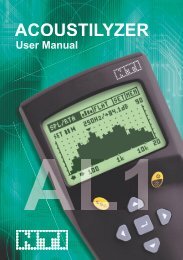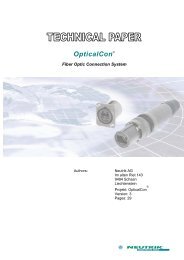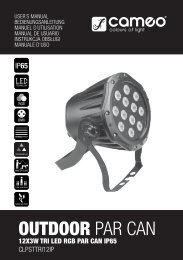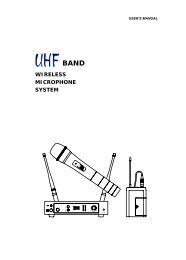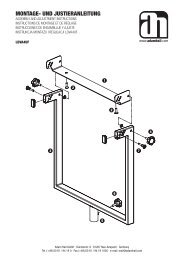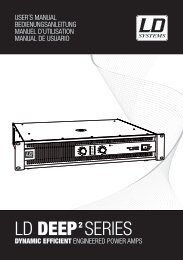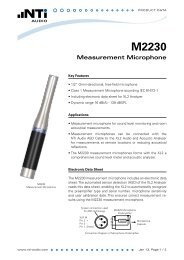Speech Intelligibility - Elma Instruments
Speech Intelligibility - Elma Instruments
Speech Intelligibility - Elma Instruments
You also want an ePaper? Increase the reach of your titles
YUMPU automatically turns print PDFs into web optimized ePapers that Google loves.
NTI TalkBox<br />
STI-PA Test Result<br />
APPlicAtion note<br />
cluding the microphone. This is the most realistic system check<br />
in any event.<br />
• No electrical input is available to induct the electrical test signal.<br />
• The level of the test signal is not clearly defined<br />
• The characteristics of the speaker’s acoustical environment are<br />
not negligible and flat.<br />
• The characteristics, sensitivity and frequency response of the<br />
speaker’s microphone is not known but needs to be considered.<br />
• As above, if for any other reason it is desirable to test the entire<br />
signal chain under real conditions.<br />
• The TalkBox is also capable of delivering white and pink noise<br />
and other special signals, and so is a very useful overall tool for<br />
system tuning and testing.<br />
• The intelligibility index is measured in the range from 0 to 1,<br />
whereby 1 is perfect and the minimum requirement including<br />
measurement uncertainty and variation is >= 0.5.<br />
• The variation of STI-PA test results shall be smaller than 0.03<br />
STI at one test position, thus to fulfill measurement conditions<br />
for ambient noise characteristics. The actual variation shall be<br />
measured at a representative location.<br />
• Best intelligibility is achieved at message levels in the range<br />
of 70-80 dBSPL. At higher sound pressure levels the selfprotection<br />
of the ear comes into action, which is reflected in<br />
a reduced intelligibility index, such as a STI of 1 at 70 dBSPL<br />
may be down to 0.7 STI at higher sound pressure level.<br />
• Based on the random STI-PA test signal the typical variations<br />
of the measurements is 0.01 – 0.03 STI. Thus at applications<br />
with STI-PA values < 0.63 STI the measurement has to be<br />
repeated twice and the arithmetical average of all 3 measurements<br />
calculated.<br />
• In case variations are higher than 0.03 STI, further 3 measurement<br />
shall be carried out and all 6 readings arithmetical averaged.<br />
• In case variations at the same test location are higher than<br />
0.05 STI, causes for these discrepancies shall be detected,<br />
eliminated and the measurement repeated.<br />
www.nti-audio.com Page 11 / 14



